- Home
- Julian May
The Sagittarius Whorl Page 15
The Sagittarius Whorl Read online
Page 15
"Who's the owner of record?" I asked.
"Livonia Holdings SC, a Carnelian subsidiary, bought it from Galapharma after Alistair Drummond's death. About a year ago Livonia leased the place to S'yoma tib Katatosi—a Y'tata trading company—after installing a heavy-duty ventilation system. The Y's wanted it for an executive vacation retreat. An entity that I reached at the Y'tata embassy claims that the Katatosi outfit is only sporadically in residence on Earth. Conveniently absent at present. The entity was of the opinion that Katatosi might have sublet the house to some human business clients. The place was automatically supplied with food and the like by RoboGrocer and kept clean by Livonia-programmed domestic bots. There was no live-in human help."
"Uh-huh. What about the security system?"
"That fed to a Y outfit in Toronto that alerted the local fire crew. The Y'tata security entities refused to give me any specifics."
"This suggestion of a Y'tata-Haluk connection could be significant, Karl. When I talked to Jake Silver about the Barky Hunt Friday night, he told me about a suppressed ZP report about collaborating pirates of the same two races operating in Zone 3, hijacking transactinide carriers."
"Zone 3?" Karl's expression was incredulous. "Haluk in the Sagittarius Whorl? That doesn't sound likely."
"I didn't think so, either. But Jake's source said that the Haluk presence was deliberately hushed up by Xenoaffairs. Maybe the blueballs are encouraging Y'tata freebooters to steal ultraheavy elements so that there'll be a shortage."
"To increase the profitability of their own trans-ack trade with us?"
"Maybe. Barky Tregarth is supposed to be hanging out in Zone 3, too. Jake got me a solid lead on him that I intend to check out as soon as possible. If the Haluk are operating in the Sag, I'll bet Barky knows about it."
"There's more bad news," Karl said, "maybe unconnected to this business. Lorne Buchanan is dead. Apparently a suicide."
"My God! The secret Galapharma file data—"
"Relax. Everything pertaining to the Haluk was transferred to Efrem Sontag on Friday evening, just as Buchanan had agreed. His body was found Saturday morning in his Rosedale house. There was no note. He had apparently shot himself in the head with an antique Glock handgun."
"The poor bastard didn't kill himself," I declared. "You know that as well as I do, Karl! The Haluk found out what he'd done and murdered him. Maybe to discourage other Galapharma executives from coming forward with evidence against them."
"We'll never prove it."
"Probably one of those security people Buchanan brought to Rampart Tower—" I started to say.
"Any demis in the bunch will be long gone by the time we're able to check their DNA. It's a dead end, Helly. Now that they know we can spot them with the genetic marker, they'll be ultracautious."
"Shit. I hoped we'd be able to keep the Haluk in the dark about that—at least for a little while longer."
The good doctor had been looking more and more dismayed as the mystifying two-way conversation proceeded. I said, "Charlie, it's about time we put you into the picture."
He said, "Did I understand you to say that Haluk were responsible for your abduction yesterday? And for Buchanan's murder?"
"Yep. They probably kidnapped my brother Daniel, too."
"That's appalling! Why haven't you notified the Secretariat for Xenoaffairs?"
"Because SXA is hand in glove with the consortium and the other members of the Hundred Concerns who have a vested interest in keeping the Haluk happy. SXA knows very well that I have a hard-on for our devious blue brethren. As we lawyers would say, I am not a credible accusant."
"Then inform CCID—"
"There's something else, Charlie. Bea's probably working to prove it even as we speak. The Haluk who tried to nab me were demiclones. They had been illegally engineered into perfect human replicas."
"What! And the dead man in my morgue—"
"Is almost certainly an alien. Bea will know for certain when she finishes her genetic assay. The Haluk have been using demiclones as secret agents against humanity for several years now—predating their treaties with us."
"I can't believe that no one in authority knows about this!"
"People in Xenoaffairs and Interstellar Commerce almost certainly have proof of demiclone activity on Earth and on other human worlds that they've concealed from the public and the Commonwealth Assembly. But no one in SXA or ICS will blow the whistle because high officials in both secretariats are creatures of Big Business. Mustn't endanger the profits of the Haluk Consortium."
I'd finished the pizza and salad, and now I started on the slab of German chocolate cake. "Let me tell you the story, Charlie. It's a real seven-ply gasser."
The scheme was hatched from a miscegenation of deluded idealism and corporate greed. It started with a crackpot idea conceived by a naive woman who hoped to foment peace and love between the Haluk and humanity by means of genetic engineering.
Emily Blake Konigsberg was a brilliant and very attractive scientist who worked for Galapharma in the years before its unscrupulous CEO decided to take over the Rampart worlds. Emily and Alistair Drummond became lovers. In the course of their pillow talk she told him about her great dream.
Emily was keenly interested in the Haluk and deplored the fact that our two races were enemies. As you know, the Haluk bitterly resented the fact that we halted their aggressive expansion into the Perseus Spur, forced them to accept a humiliating armistice, and declined to share our advanced technology with them. It was Emily's belief that the refusal of the Haluk to even consider detente was largely rooted in their envy of our stable physiology. She was probably right.
Humanity was spawned on a relatively benign planet. Aside from some relatively minor seasonal glitches, we're physically and mentally operational all year round. But the Haluk evolved on a world with a highly eccentric orbit that annually carried it into a region of intense solar radiation. The result was allomorphy, an adaptation that originally enabled the race to survive.
For about two hundred days each year, while the home planet was sufficiently distant from its sun, the ancestral Haluk existed as smart, active, sexual, somewhat humanoid individuals called gracilomorphs. But then, as the orbiting world approached the zone of strong solar radiation, Haluk bodies underwent protective changes. For about sixty days, during their lepidodermoid phase, they became increasingly thick-skinned and sluggish. They lost their sexuality. Their brains began to power down, leaving them incapable of high mental function. Finally, in a climactic Big Change, the lepidos morphed into a coffinlike testudinal phase. They slept inside radiation-resistant golden chrysalids for 140 days. When the home planet once again swung away from its ferocious sun, gracile Haluk awakened from estivation and emerged from their protective shells to carry on their interrupted lives.
Eventually the Haluk achieved interstellar travel. On new planets, allomorphy was no longer a survival trait but instead a tremendous inconvenience that slowed racial progress. Millennia passed. As the Haluk expanded throughout their star-cluster, the allomorphic cycles of individuals lost their ancestral synchrony. This lessened the annual nuisance somewhat. At least they weren't all asleep at the same time. But their civilization—and most particularly their science—suffered a great disadvantage compared to that of other stargoing sapients.
Especially humans.
The Haluk entered the Milky Way Galaxy at the tip of the Perseus Spur and established eleven colonial planets. At the time, the only local race having starships were the Qastt, and they were easily subjugated. But when humanity extended its powerful hegemony to the Spur, Haluk expansion was stopped cold by our superior technology.
So they hated and feared us and refused to trade or enter into normal diplomatic relations.
Emily Konigsberg told her lover, Drummond, that she was convinced Haluk hostility could be mitigated and the race's great potential realized if their allomorphy were to be eradicated. It was her opinion that the job could be done easily
through advanced techniques of genetic engineering. She sincerely believed that Commonwealth policy denying this technology to the Haluk was immoral. If Galapharma Concern could see its way clear to bypass CHW strictures—that is, work with her to set up genen therapy programs among the blue aliens—a great wrong would be righted.
Alistair Drummond didn't have an altruistic bone in his body, but he liked Konigsberg's idea all the same. The Haluk Cluster was rumored to possess abundant supplies of valuable transactinide elements, which the aliens had heretofore adamantly refused to trade. Galapharma stood to make enormous profits in the therapy venture, doing well by doing good.
So Alistair entered into secret negotiations with the Haluk leader, the Servant of Servants of Luk, and the deal was done. Emily set up a genetic engineering lab on the principal Haluk Spur colony, Artiuk, staffed entirely by Galapharma personnel. The project achieved success by inserting human genes into the Haluk. Modified alien individuals remained in the active, brainy, gracile phase permanently. And because the therapy also modified Haluk germ cells—so did their offspring.
The great achievement was doubly illegal under Commonwealth law, which forbade meddling with the genetic heritage of a sovereign race, to say nothing of sharing human DNA with aliens. This didn't bother Alistair Drummond. Galapharma was one of the almighty Big Seven Concerns. He figured that if they were caught, they could pressure the Commonwealth Assembly to legalize the scheme retroactively since it was good for business.
Eventually, that's just what happened.
It was a minor embarrassment to Emily Konigsberg that the only viral vector suitable for allomorph eradication therapy was not one under patent to Galapharma Amalgamated Concern. PD32:C2 was an exclusive product of Gala's small rival, Rampart Starcorp, which had obtained the CHW mandate to the Perseus Spur after Galapharma withdrew in 2176. The vector could not be grown under laboratory conditions or synthesized; its sole source was the planet Cravat, owned by Rampart.
PD32:C2 could be purchased on the open market, of course—cautiously, so Rampart would not know that the stuff was being resold at an enormous markup—or it could be stolen. Gala agents and Haluk pirates pursued both courses of action, while Alistair Drummond tried to engineer a hostile takeover of Rampart in order to regain control of the Spur planets—especially Cravat—that Galapharma had so imprudently let slip out of its hands.
At the same time, the wily CEO encouraged other large Concerns—Sheltok, Carnelian, Bodascon, and Homerun— to join the illicit Haluk trading partnership. There was safety in numbers, and plenty of profits to go around. The Haluk were hungry for all kinds of advanced human technology and willing to pay through the nose.
Emily and Alistair were no longer romantically involved. Her idealistic pursuit of a "greater good" allowed her to turn a blind eye to the commercial shenanigans orchestrated by her ex-lover while she expanded the therapy program, training Haluk scientists to build and operate dynamic stasis units. The aliens were very quick learners.
Too damn quick—but none of the human conspirators had any inkling of the awful truth.
One day the Servant of Servants of Luk proposed a new genetic enterprise to Emily. He had conceived a plan that would open a great new era in Haluk-human relations. Its fulfillment required "a small number" of demiclones. These Haluk in human guise were to become special cultural envoys to the populous planets of the Haluk Cluster, supposedly soothing the intense xenophobia that had poisoned any hope of rapprochement between the two races from the time of their first encounter over a hundred years earlier.
Emily Konigsberg was dubious about this bizarre notion. Demicloning, like other extreme forms of genetic engineering, had long been outlawed in the Commonwealth of Human Worlds. But eventually she gave in to the Servant's pressure and even contributed her own DNA to the project.
When Alistair Drummond found out about the demiclones, he was furious. He believed the Servant actually intended to use fake humans to spy on the Concerns and gain trade advantages. Drummond's first inclination was to shut down the demiclone project, but he relented after the Servant hinted that serious consequences would ensue. By then, illegal trade with the Haluk had generated immense profits that Galapharma and its Concern collaborators were reluctant to forfeit.
Drummond hatched a ploy to minimize the danger of industrial espionage. He ordered Konigsberg to incorporate a genetic marker into the demiclone procedure without Haluk knowledge. In addition, the sole genen facility producing the clones was placed under strict human supervision, on a remote human world. Galapharma itself undertook to supply the luckless donors of human DNA.
Alistair Drummond's precautions worked well enough ... until the aliens learned how to perform the complex demiclone procedure without the help of human scientists, built secret labs of their own, and discovered how easy it was to defeat the sporadic DNA testing of employees that was supposed to prevent Haluk ringers from infiltrating the human race.
As I reached this point in my narrative, my pocket phone trilled. It was Cosmo Riendeau. I excused myself from the table and went to answer the call in the cottage's living room, urging Karl to continue the story while I was gone.
Cosmo's report was disturbing. "Only one outsider took an interest in your starship, Helly—a very pretty young woman from the accounting department in Rampart Tower. She showed up here in Oshawa yesterday, around noon, and apparently had the proper pass and personal ID. This cutie told Ole Wiren, the day-shift supervisor, that she was at the port to reconfigure a billing procedure for our number crunchers. She said she was on lunch break and ever so curious about the big starships, and she begged Ole for a quick tour. He admits he came down with instant beaver fever and showed her around."
"She saw Makebate."
"I'm afraid so. Your boat was obviously something special—not just another freighter or ExSec cruiser. Ole told her your starship was almost ready to leave the barn—even let slip that we'd done a fuel-cell augmentation. Sorry, Helly. The whole team knew your refit was supposed to be hush-hush, but that chick played poor Ole like a Stradivarius."
"Probably no harm done," I lied. "Did the woman give her name?"
"Dolores da Gama. I pulled her image and voice-signature off the shop entry security monitor for you. Hold on while I feed a dime."
He inserted a data disklet into his phone and a talking image popped onto my screen. Da Gama was stacked like a brick shithouse and had wide-set dark eyes, pouty lips, and long black hair with a white blaze at the left temple. She talked her way past the laxly guarded entrance to Rampart Fleet Maintenance using a voice as sweet and seductive as fireweed honey. If Dolores was a demiclone, her original must have been a real hottie.
I cut off the replay. "Thanks for the information, Cosmo. I'll look into this, but I'm sure everything's okay."
"Anything else I can do for you, Helly?"
"I'd like to lift off sometime early next week. Think you'd have time to rig simple arm and leg restraints on the copilot's chair—plus an exterior lock on the John door?"
"Prisoner transport, eh?"
"Something like that."
"I'll attend to it personally."
I thanked him and hit the End pad, then used the phone to access Rampart's roster of accounting personnel.
There was no Dolores da Gama. Why wasn't I surprised?
I sent a copy of her mug shot to Sean Callahan at InSec and told him to pass it along to his supervisor. I doubted that the lovely lady would press her luck and try another incursion, but Rampart Tower's doorkeepers had to be put on alert.
And I had to get out of town before a fresh set of demiclone thugs came sniffing after me.
However, there was still unfinished business to be taken care of with Simon, Ef Sontag, and a few other people. I also needed to assemble certain items crucial to a successful Barky Hunt that probably wouldn't be available off-Earth.
I sat for a few minutes, thinking, then made two brief calls. The first was to Tony Becker, Rampart's brill
iant but testy Vice President for Biotechnology, who grumped and bitched and asked questions that I didn't intend to answer. He only agreed to put together what I needed when I used both a carrot and a stick: the promise of a hefty bribe, plus a half-joking threat to have him fired if he didn't come through.
The second call went to Halimeda Opper, a venerable and trustworthy Reversionist party stalwart who was a media production designer by profession. She heard me out, then referred me to a theatrical supply house in Mississauga that would have exactly what I required.
I returned to the kitchen and helped myself to a second piece of German chocolate cake. Next to snickerdoodle cookies and rozkoz flan, it's my favorite confection. Karl was regaling Charlie with accounts of our more recent adventures with the Haluk—demiclone and au naturel—on Dagasatt and on the journey back to Earth following my capture of Oliver Schneider. I lowered my eyes modestly during the heroic parts, which seemed a lot more fun in retrospect than they'd been at the time.
When Karl wound down, Charlie said, "I'm still not clear on the aliens' motivation. Trade between humanity and the Haluk is regularized. On the face of it, we're friends. So why the continuing demiclone espionage?"
"Why indeed," I murmured. "Perhaps the Haluk have a hidden agenda that involves more than taking care of business. Perhaps they've had that agenda from the inception of the demiclone scheme! What if their moles have dug deep into the inner operations of the Hundred Concerns? What if they're rooting around inside our scientific establishment, our law enforcement agencies, and our government?"

 The Many-Coloured Land
The Many-Coloured Land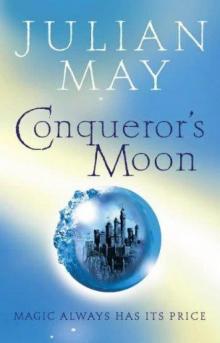 Conqueror's Moon
Conqueror's Moon The Sagittarius Whorl
The Sagittarius Whorl The Nonborn King
The Nonborn King Sky Trillium
Sky Trillium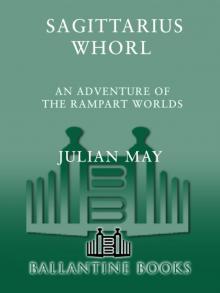 The Sagittarius Whorl: Book Three of the Rampart Worlds Trilogy
The Sagittarius Whorl: Book Three of the Rampart Worlds Trilogy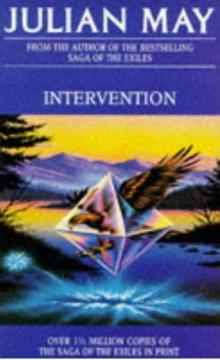 Intervention
Intervention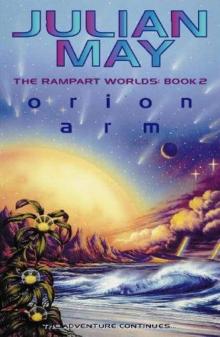 Orion Arm
Orion Arm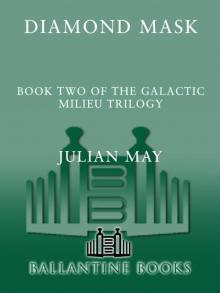 Diamond Mask
Diamond Mask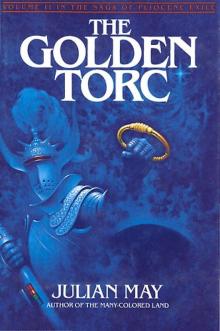 The Golden Torc
The Golden Torc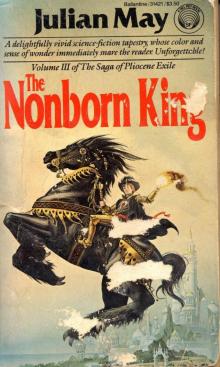 The Noborn King
The Noborn King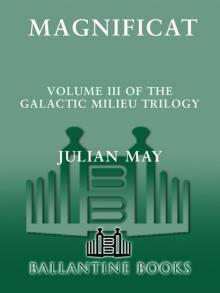 Magnificat
Magnificat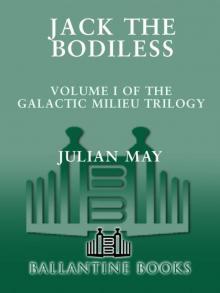 Jack the Bodiless
Jack the Bodiless Perseus Spur
Perseus Spur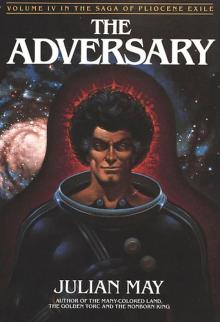 The Adversary
The Adversary Sorcerer's Moon
Sorcerer's Moon Sagittarius Whorl
Sagittarius Whorl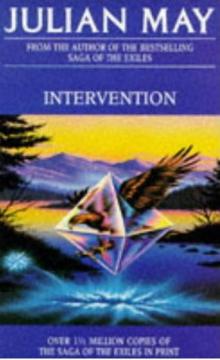 The Intervention (Omnibus)
The Intervention (Omnibus)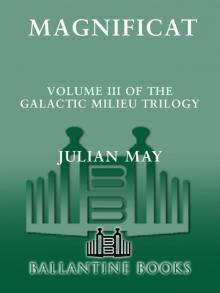 Magnificat (Galactic Milieu Trilogy)
Magnificat (Galactic Milieu Trilogy)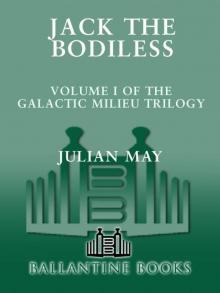 Jack the Bodiless (Galactic Milieu Trilogy)
Jack the Bodiless (Galactic Milieu Trilogy) Diamond Mask (Galactic Milieu Trilogy)
Diamond Mask (Galactic Milieu Trilogy) The Many-Coloured Land sope-1
The Many-Coloured Land sope-1